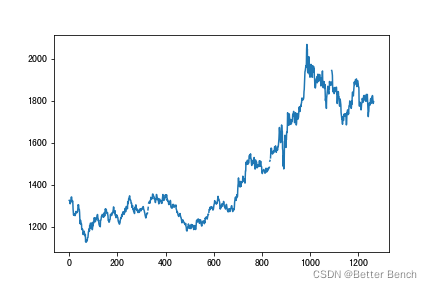目录
更新时间:2022-2-21 15:00
相关链接
完整代码和参考文献下载:https://www.betterbench.top/#/30/detail
或者私信我
1 题目
要求开发一个模型, 这个模型只使用到目前为止的过去的每日价格流来确定,每天应该买入、 持有还是卖出他们投资组合中的资产。
2016 年 9 月 11 日, 将从 1000 美元开始。 将使用五年交易期, 从 2016 年 9 月 11 日到2021 年 9 月 10 日。 在每个交易日, 交易者的投资组合将包括现金、 黄金和比特币[C, G, B],分别是美元、 金衡盎司和比特币。 初始状态为[1000,0,0]。 每笔交易(购买或销售)的佣金是交易金额的α%。 假设
α
g
o
l
d
\\alpha _{gold}
αgold= 1%,
α
b
i
t
c
o
i
n
\\alpha_{bitcoin}
αbitcoin = 2%。 持有资产没有成本。
请注意, 比特币可以每天交易, 但黄金只在市场开放的日子交易(即周末不交易), 这反映在定价数据文件LBMA-GOLD.csv 和 BCHAIN-MKPRU.csv 中。 你的模型应该考虑到这个交易计划, 但在建模过程中你只能使用其中之一。
-
开发一个模型, 仅根据当天的价格数据给出最佳的每日交易策略。 使用你的模型和策略,
在 2021 年 9 月 10 日最初的 1000 美元投资价值多少? -
提供证据证明你的模型提供了最佳策略。
-
确定该策略对交易成本的敏感度。 交易成本如何影响战略和结果?
-
将你的策略、 模型和结果以一份不超过两页的备忘录的形式传达给交易者。
注意: 您的 PDF 总页数不超过 25 页, 解决方案应包括: -
一页摘要表。 目录。 完整的解决方案。 一到两页附录。 参考文献。
注:MCM 竞赛有 25 页的限制。 您提交的所有方面都计入 25 页的限制(摘要页、 目录、 参考文献和任何附录)。 必须在你的报告中标注你的想法、 图像和其他材料的来源引用
2 思路解析
3 Python 实现
3.1 数据分析和预处理
(1)数据分析
import pandas as pd
import matplotlib.pyplot as plt
import numpy as np
gold = pd.read_csv('./data/LBMA-GOLD.csv')
bitcoin = pd.read_csv('./data/BCHAIN-MKPRU.csv')
gold.info()
<class ‘pandas.core.frame.DataFrame’>
RangeIndex: 1265 entries, 0 to 1264 Data columns (total 2 columns):
Column Non-Null Count Dtype — —— ————– —–
0 Date 1265 non-null object
1 USD (PM) 1255 non-null float64
dtypes: float64(1), object(1)
# 缺失值查看
gold.isnull().any()
Date False
USD (PM) True
dtype: bool
黄金序列存在缺失值
bitcoin.isnull().any()
Date False
Value False
dtype: bool
比特币序列没有缺失值
可视化数据
x1 = range(len(gold))
y1 = gold['USD (PM)']
x2 = range(len(bitcoin))
y2 = bitcoin['Value']
plt.plot(x1,y1)


plt.plot(x2,y2,color='r')
(2)数据预处理
黄金序列是有缺失值,且周末不存在数据,时间序列是中断的,以下采用插值法进行填充数据,将补充为完整的时间序列
gold.index = list(pd.DatetimeIndex(gold.Date))
gold_datalist = pd.date_range(start='2016-09-12',end='2021-09-10')
ts = pd.Series(len(gold_datalist)*[np.nan],index=gold_datalist)
gold_s = gold['USD (PM)']
for i in gold.index:
ts[i] = gold_s[i]
# 线性插值法
ts = ts.interpolate(method='linear')
gold_df = ts.astype(float).to_frame()
gold_df.rename(columns={0:'USD'},inplace=True)
gold_df.sort_index()
gold_df.index = range(len(gold_df))
gold_df
补充完整后,黄金的时间序列有1825条数据
3.2 预测
(1)特征工程
# 提取特征
from tsfresh import extract_features, extract_relevant_features, select_features
from tsfresh.utilities.dataframe_functions import impute
gold_df['id'] = range(len(gold_df))
extracted_features = extract_features(gold_df,column_id='id')
extracted_features.index = gold_df.index
# 去除NAN特征
extracted_features2 = impute(extracted_features)
构造训练集
import re
# 向未来移动一个时间步长
timestep = 1
Y = list(gold_df['USD'][timestep:])
X_t = extracted_features2[:-timestep]
X = select_features(X_t, np.array(Y), fdr_level=0.5)
X = X.rename(columns = lambda x:re.sub('[^A-Za-z0-9_]+', '', x))
(2)模型训练预测
# 划分30%作为测试集
s = 0.3
tra_len = int((1-s)*len(X))
test_len = len(X)-tra_len
X_train, X_test, y_train, y_test = X[0:tra_len], X[-test_len:], Y[0:tra_len],Y[-test_len:]
# 方法一
import lightgbm as lgb
# clf = lgb.LGBMRegressor(
# learning_rate=0.01,
# max_depth=-1,
# n_estimators=5000,
# boosting_type='gbdt',
# random_state=2022,
# objective='regression',
# )
# clf.fit(X=X_train, y=y_train, eval_metric='MSE', verbose=50)
# y_predict = clf.predict(X_test)
# 方法二
from sklearn.model_selection import train_test_split
from sklearn.linear_model import LinearRegression
import matplotlib.pyplot as plt
linreg = LinearRegression()
model = linreg.fit(X_train, y_train)
y_pred = linreg.predict(X_test)
预测及输出评价指标
from sklearn import metrics
def metric_regresion(y_true,y_pre):
mse = metrics.mean_squared_error(y_true,y_pre)
mae = metrics.mean_absolute_error(y_true,y_pre)
rmse = np.sqrt(metrics.mean_squared_error(y_true,y_pre)) # RMSE
r2 = metrics.r2_score(y_true,y_pre)
print('MSE:{}'.format(mse))
print('MAE:{}'.format(mae))
print('RMSE:{}'.format(rmse))
print('R2:{}'.format(r2))
metric_regresion(y_test,y_pred)
MSE:267.91294723114646
MAE:10.630377450265746
RMSE:16.368046530699576
R2:0.9707506268528148
可视化预测结果
import matplotlib.pyplot as plt
plt.figure()
plt.plot(range(len(y_pred[100:180])), y_pred[100:180], 'b', label="预测")
plt.plot(range(len(y_test[100:180])), y_test[100:180], 'r', label="原始")
plt.legend(loc="upper right", prop={'size': 15})
plt.show()

3.3 进阶的预测方案和代码
import pandas as pd
import numpy as np
import warnings
warnings.filterwarnings('ignore')
import statsmodels.api as sm
import matplotlib.pyplot as plt
import matplotlib as mpl
import itertools
plt.style.use("fivethirtyeight")
gold = pd.read_csv('LBMA-GOLD.csv')
bitcoin = pd.read_csv('BCHAIN-MKPRU.csv')
gold.index = list(pd.DatetimeIndex(gold.Date))
bitcoin.index = list(pd.DatetimeIndex(bitcoin.Date))
bitcoin['Date'] = bitcoin.index
gold['Date'] = gold.index
y=bitcoin["Value"].resample("MS").mean()#获得每个月的平均值
print(y.isnull().sum)#5个 检测空白值
#处理数据中的缺失项
y=y.fillna(y.bfill())#填充缺失值
plt.figure(figsize=(15,6))
plt.title("intial",loc="center",fontsize=20)
plt.plot(y)
#找合适的p d q
#初始化 p d q
p=d=q=range(0,2)
print("p=",p,"d=",d,"q=",q)
#产生不同的pdq元组,得到 p d q 全排列
pdq=list(itertools.product(p,d,q))
print("pdq:\\n",pdq)
seasonal_pdq=[(x[0],x[1],x[2],12) for x in pdq]
print('SQRIMAX:{} x {}'.format(pdq[1],seasonal_pdq[1]))
# 时间序列搜索最优参数(比特币为例,黄金同理)
for param in pdq:
for param_seasonal in seasonal_pdq:
try:
mod = sm.tsa.statespace.SARIMAX(y,
order=param, seasonal_order=param_seasonal, enforce_stationarity=False, enforce_invertibility=False)
results = mod.fit()
print('ARIMA{}x{}12 - AIC:{}'.format(param, param_seasonal, results.aic))
except:
continue
mod = sm.tsa.statespace.SARIMAX(y,
order=(1, 1, 1),
seasonal_order=(1, 1, 0, 12),
enforce_stationarity=False,
enforce_invertibility=False)
results = mod.fit()
print(results.summary().tables[1])
results.plot_diagnostics(figsize=(15, 12))
plt.show()
# #进行验证预测
pred=results.get_prediction(start=pd.to_datetime('2017-01-01'),dynamic=False)
pred_ci=pred.conf_int()
print("pred ci:\\n",pred_ci)#获得的是一个预测范围,置信区间
print("pred:\\n",pred)#为一个预测对象
print("pred mean:\\n",pred.predicted_mean)#为预测的平均值
#进行绘制预测图像
plt.figure(figsize=(10,6))
ax=y['1990':].plot(label="observed")
pred.predicted_mean.plot(ax=ax,label="static ForCast",alpha=.7,color='red',linewidth=2)
#在某个范围内进行填充
ax.fill_between(pred_ci.index,
pred_ci.iloc[:, 0],
pred_ci.iloc[:, 1], color='k', alpha=.2)
ax.set_xlabel('Date')
ax.set_ylabel('bi Levels')
plt.legend()
plt.show()
pred_dynamic = results.get_prediction(start=pd.to_datetime('2017-01-01'), dynamic=True, full_results=True)
pred_dynamic_ci = pred_dynamic.conf_int()
# #使用动态预测
pred_dynamic = results.get_prediction(start=pd.to_datetime('2017-01-01'), dynamic=True, full_results=True)
pred_dynamic_ci = pred_dynamic.conf_int()
ax = y['2017':].plot(label='observed', figsize=(20, 15))
pred_dynamic.predicted_mean.plot(label='Dynamic Forecast', ax=ax)
ax.fill_between(pred_dynamic_ci.index,
pred_dynamic_ci.iloc[:, 0],
pred_dynamic_ci.iloc[:, 1], color='k', alpha=.25)
ax.fill_betweenx(ax.get_ylim(), pd.to_datetime('2017-01-01'), y.index[-1],
alpha=.1, zorder=-1)
ax.set_xlabel('Date')
ax.set_ylabel('bi Levels')
plt.legend()
plt.show()
# Get forecast 500 steps ahead in future
pred_uc = results.get_forecast(steps=200)#steps 可以代表(200/12)年左右
# Get confidence intervals of forecasts
pred_ci = pred_uc.conf_int()
plt.title("预测",fontsize=15,color="red")
ax = y.plot(label='observed', figsize=(20, 15))
pred_uc.predicted_mean.plot(ax=ax, label='Forecast')
ax.fill_between(pred_ci.index,
pred_ci.iloc[:, 0],
pred_ci.iloc[:, 1], color='k', alpha=.25)
ax.set_xlabel('Date',fontsize=15)
ax.set_ylabel('bi Levels',fontsize=15)
plt.legend()
plt.show()
3.4 动态规划
3.4.1 思路方案
符号说明
w
1
w_1
w1,
w
2
w_2
w2 初始买入比例
P
t
P_t
Pt,
P
t
−
1
P_{t-1}
Pt−1 前后一天价格
diff 前后一天价格差
Y
t
Y_t
Yt 变化收益
b% 中途卖出比例(也是买入比例)
目标函数:
m
a
x
max
max
Y
t
Y_t
Yt =
W
1
W_1
W1
P
黄
P_黄
P黄+
W
2
W_2
W2
P
比
P_比
P比
约束条件:
1、
C
=
W
1
×
P
×
b
%
×
1
%
+
W
i
×
P
×
b
%
×
2
%
C=W_1×P × b\\% ×1\\%+W_i × P × b \\% × 2 \\%
C=W1×P×b%×1%+Wi×P×b%×2%(成本约束)(买出卖出成本)
2、
X
i
=
{
0
x
0
=周末
1
x
1
!=周末
X_i= \\begin{cases} 0& \\text{$x_0$=周末}\\\\ 1& \\text{$x_1$ !=周末} \\end{cases}
Xi={01x0=周末x1 !=周末
3、diff=
P
t
P_t
Pt–
P
t
−
1
P_{t-1}
Pt−1 (持有会带来的成本)
4、
0
≤
r
≤
1
0 \\leq r \\leq 1
0≤r≤1 风险系数约束(可用预测模型的置信区间权衡风险)
3.4.2 思路2
符号说明
目标函数
M
a
x
∑
i
n
g
a
i
n
i
Max {\\sum _i^n{gain_i}}
Max∑ingaini
i表示第i天的交易,取值1-n
j表示是否是周末,取值0或1,0表示不是周末, 1表示周末
g
a
i
n
i
gain_i
gaini表示第i天的最大收益
g
i
j
g_{ij}
gij表示第i天的黄金价格
b
i
j
b_{ij}
bij表示第i天的比特币价格
x
i
j
x_{ij}
xij表示第i天购入的黄金数量,单位美元/盎司
y
i
j
y_{ij}
yij表示第i天购入的比特币数量,单位美元/个
g_i =[5,20,56,23,4,5,6]
b_i =[2,3,4,4,5,5,66,7]

3.4.3 思路3
我们用buy表示在最大化收益的前提下,如果我们手上拥有一支股票,那么它的最低买入价格是多少。在初始时,buy 的值为prices[0] 加上手续费fee。那么当我们遍历到第 i (i>0) 天时:
如果当前的股票价格prices[i] 加上手续费fee 小于buy,那么与其使用buy 的价格购买股票,我们不如以prices[i]+fee 的价格购买股票,因此我们将buy 更新为prices[i]+fee;
如果当前的股票价格prices[i] 大于buy,那么我们直接卖出股票并且获得prices[i]−buy 的收益。但实际上,我们此时卖出股票可能并不是全局最优的(例如下一天股票价格继续上升),
因此我们可以提供一个反悔操作,看成当前手上拥有一支买入价格为 prices[i] 的股票,将buy 更新为prices[i]。这样一来,如果下一天股票价格继续上升,
我们会获得prices[i+1]−prices[i] 的收益,加上这一天prices[i]−buy 的收益,恰好就等于在这一天不进行任何操作,而在下一天卖出股票的收益;
对于其余的情况,prices[i] 落在区间[buy−fee,buy] 内,它的价格没有低到我们放弃手上的股票去选择它,也没有高到我们可以通过卖出获得收益,因此我们可以卖出去交易比特币。
上面的贪心思想可以浓缩成一句话,即当我们卖出一支股票时,我们就立即获得了以相同价格并且免除手续费买入一支股票的权利。在遍历完整个数组prices 之后之后,我们就得到了最大的总收益。
3.3.2 Python实现
完整数学模型和代码下载:https://www.betterbench.top/#/30/detail











![[转]我国CAD软件产业亟待研究现状采取对策-卡核](https://www.caxkernel.com/wp-content/uploads/2024/07/frc-f080b20a9340c1a89c731029cb163f6a-212x300.png)











暂无评论内容